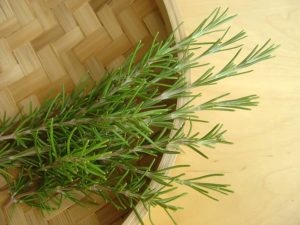Viewed from a distance while in bloom, it’s easy to understand how the herb rosemary got its name. The Latin name for rosemary is ros marinus which means “sea dew” or “sea spray.
Rosemary in bloom is covered with small clusters of shimmering blossoms of both light and deep blue. This tough but marvelously fragrant plant had its origins on the seaside cliffs of the Mediterranean and has been adopted in cookery far beyond its origin.
Ways to use rosemary
- The leaves, sprigs, stems, and flowers can all be used as a seasoning in soups, salads, vegetables, meats, fish, egg dishes, stuffings, and dressings.
- Rosemary has both a sweet and bitter pungency. You may detect hints of lemon and pine in freshly crushed rosemary as well as hints of nutmeg and camphor in its aftertaste.
- Rosemary is most tender in early spring. In late summer, you will find it more resinous and potent.
- The flavor of rosemary dissipates after the leaves have been cut, so temper your use of rosemary by tasting. It’s best to use less of rosemary than more so chop it finely and add it sparingly. Used to excess rosemary can leave an acrid taste in your mouth.
- Rosemary complements fatty, strong-tasting meats such as lamb, pork, duck, and game. Add this herb to casseroles, tomato sauces, baked fish, apples, summer wine cups, cordials, vinegar, and oils.
- Rosemary matches well with garlic and red wine. The spicy, pungent tough leaves of late-season rosemary are strongly aromatic and peppery and will add to the roasting or grilling of meat. Use rosemary sprigs to flavor grilling charcoals or use sprigs to brush olive oil on meat and poultry before roasting.
- Rosemary flowers are sweetly perfumed and delicious on salads, rice, pasta, or fruit salads. Rosemary blossoms also yield a fragrant honey.

How to choose rosemary
Snip fresh rosemary foliage as needed all year. Fresh rosemary is best.
How to store rosemary
Rosemary will keep in a plastic bag in the refrigerator for up to one week. It can also be frozen in plastic bags. You can dry rosemary sprigs and branches for later use, or you can strip off the leaves before storing them. Dried rosemary should be kept in a cool, dark, dry place. Whole dried rosemary will keep for up to one year. Tie fresh rosemary in bunches and air-dry.
How to prepare rosemary
When you are ready to use rosemary, chop or pulverize the leaves to release the aromatic oils.
Serving rosemary
Use leaves with meat dishes such as lamb, pork, poultry, and fish. Use sprigs to brush olive oil on meat and poultry when grilling. Toss stems on the grill to flavor barbeques. Put sprigs on charcoal for extra flavor. Use sprigs in marinades for lamb. Combine rosemary with a little lemon juice and chopped parsley then sprinkle on chicken before baking. Stuff chicken with rosemary sprigs, quartered lemon, and garlic cloves when roasting.
- Use rosemary to flavor baked potatoes. Use chopped rosemary with cheeses, bread, vegetables, pizza, soups, marinades, beans, vinegar, or beverages. Add rosemary to olive oil to fry vegetables. Use rosemary in cookies, crackers, and in focaccia and bread.
- Use rosemary flowers in salads, sugar, or fruit desserts.
- Rosemary is essential to herbes de Provence which is a blend of basil, fennel seed, lavender, marjoram, rosemary, sage, summer savory, and thyme. Use this mix to season dishes of meat, poultry, and vegetables.
Rosemary flavor partners
Rosemary has a flavor affinity for apricots, beef, beet, cabbage, chestnuts, chicken, cream cheese, duck, eggplant, eggs, garlic, lamb, lemon, lentils, mushrooms, olive oil, onion, orange, parsnips, pork, potato, poultry, rabbit, red wine, tomato, turnip, veal, white beans, winter squashes, and zucchini.
Rosemary combines well with bay, chives, garlic, lavender, lovage, mint, oregano, parsley, sage, savory, and thyme.
About rosemary
Rosemary is a woody, evergreen perennial with scaly bark and dark green resinous and aromatic, needle-like leaves that are gray on the underside. This herb varies in form from stiff and upright to mounded and spreading, from about 12 to 72 inches (30-183 cm) tall. The leaves are about 1 to 1¼ inches (2.5-3.1cm) long.
Rosemary blooms from winter through spring. Each blossom is about ¼ to ½ inch (6-13 mm) across. The blooms appear in clusters along the branches.
Rosemary was used by ancient Greek and Roman cooks as both a seasoning and natural preservative. From Italy, rosemary gained acceptance in Northern Europe as a flavoring for sausagemeat, sucking pig, and roast lamb.
The botanical name of rosemary is Rosemarinus officinalis.
Articles of interest:
Best Herbs for Container Growing
Garden Planning Books at Amazon:
- Vegetable Garden Almanac & Planner
- Kitchen Garden Grower’s Guide Vegetable Encyclopedia
- Vegetable Garden Grower’s Guide
- Tomato Grower’s Answer Book
More kitchen tips:
Bring your harvest to the table. Kitchen prep tips and easy recipes for the vegetables you grow. Click below for vegetable prep and recipes you can use now.
- Almonds
- Apples
- Apricot
- Aprium
- Artichoke
- Arugula
- Asparagus
- Avocado
- Bamboo Shoots
- Banana
- Basil
- Beans, Dried
- Beans. Long
- Beans, Shell
- Beans, Snap
- Beets
- Bitter Melon
- Blackberry
- Bok Choy
- Broccoli
- Broccoli Raab
- Brussels Sprouts
- Cabbage
- Cardoon
- Carrots
- Cauliflower
- Celeriac
- Celery
- Chard
- Chayote Squash
- Cherimoya
- Cherries
- Chestnut
- Chickpea
- Chinese Cabbage
- Chives
- Cilantro
- Citron
- Clementine
- Collards
- Coriander
- Corn, Sweet
- Corn, Baby
- Corn Salad, Mache
- Cranberry
- Cress
- Cucumber
- Daikon
- Dandelion
- Dill
- Eggplant
- Endive, Belgian
- Endive and Escarole
- Fava Beans
- Fig
- Florence Fennel
- Garlic
- Ginger
- Grapefruit
- Grapes
- Guava
- Horseradish
- Jerusalem Artichoke
- Jicama
- Jujube
- Kale
- Kiwifruit
- Kohlrabi
- Kumquat
- Leeks
- Lemongrass
- Lemons
- Lettuce
- Lime
- Mache (Corn Salad)
- Mandarin Orange
- Mango
- Maple Syrup
- Marjoram
- Melons
- Michihili
- Mint
- Mizuna
- Mushrooms
- Mushrooms, Cremini
- Mustard Greens
- Napa Cabbage
- Nectarine
- Okra
- Olives
- Olive oil
- Onions
- Oranges
- Oregano
- Parsley
- Parsley Root
- Parsnips
- Passion Fruit
- Pawpaw
- Peaches
- Pears
- Peas, Garden Snap
- Peas, Snow
- Pei Tsai
- Peppers, Chili
- Peppers, Sweet
- Persimmon
- Pineapple
- Pineapple Guava
- Plantain
- Plums
- Pluots
- Pomegranate
- Potatoes
- Prickly Pear
- Pumpkin
- Quince
- Radicchio
- Radishes
- Raspberries
- Rosemary
- Rhubarb
- Rutabaga
- Sage
- Salsify
- Sauerkraut
- Savory
- Shallots
- Sorrel
- Spinach
- Squash, Summer
- Squash, Winter
- Strawberries
- Sunchokes
- Sunflower
- Sweet Potato
- Swiss Chard
- Tangerine
- Taro
- Tarragon
- Thyme
- Tomatillo
- Tomato
- Turnip
- Turnip Greens
- Yams















